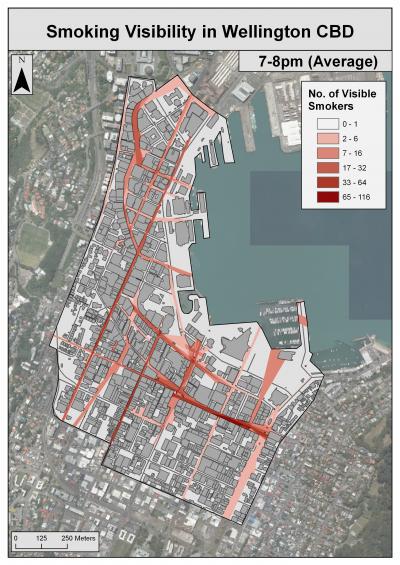Smoking visibility mapped for the first time

The visibility of smoking in city streets has for the first time anywhere been mapped, in new research from the University of Otago, Wellington, New Zealand. Data from observations across the downtown area were mapped by the researchers, producing a record of the street areas where the most smokers could be seen. They used mapping methods previously used for landscape ecology and archeology.
Credit: University of Otago, Wellington
Smoking visibility mapped for the first time
The visibility of smoking in city streets has for the first time anywhere been mapped, in new research from the University of Otago, Wellington, New Zealand.
The research found that up to 116 smokers outside bars/cafés could be seen from any one location in the outdoor public areas of downtown Wellington (e.g. on a footpath). Of 2600 people observed in the outdoor areas of bars and cafés, 16% were smoking, with a higher proportion than this in evenings.
Data from observations across the downtown area were mapped by the researchers, producing a record of the street areas where the most smokers could be seen. They used mapping methods previously used for landscape ecology and archeology.
Lead researcher Dr Amber Pearson says that the methods developed through this research will help policymakers demonstrate the visibility of smoking in different areas, and provide scientific evidence for local authorities to advance smokefree outdoor policies.
Another of the researchers, Associate Professor George Thomson, says the results show the need for policies to reduce the normality of smoking:
"Smokefree outdoor areas help smokers to quit, help those who have quit to stick with it, and reduce the normalisation of smoking for children and youth. They also reduce litter, water pollution and cleaning costs for local authorities and ratepayers," Thomson says.
In Australia, North America and other places, local authorities are increasingly creating smokefree streets and promoting smokefree al fresco dining and drinking, he says.
###
The study has been published in the international journal BMC Public Health and was funded by the Cancer Society of New Zealand (Wellington Branch).


 John Mazenier: Gaffer Tape And Glue Delivering New Zealand’s Mission Critical Services
John Mazenier: Gaffer Tape And Glue Delivering New Zealand’s Mission Critical Services Earthquake Commission: Ivan Skinner Award Winner Inspired By Real-life Earthquake Experience
Earthquake Commission: Ivan Skinner Award Winner Inspired By Real-life Earthquake Experience Reserve Bank: Consultation Opens On A Digital Currency For New Zealand
Reserve Bank: Consultation Opens On A Digital Currency For New Zealand NIWA: Ship Anchors May Cause Extensive And Long-lasting Damage To The Seafloor, According To New Research
NIWA: Ship Anchors May Cause Extensive And Long-lasting Damage To The Seafloor, According To New Research New Zealand Customs Service: A Step Forward For Simpler Trade Between New Zealand And Singapore
New Zealand Customs Service: A Step Forward For Simpler Trade Between New Zealand And Singapore Horizon Research: 68% Say Make Banks Offer Fraud Protection
Horizon Research: 68% Say Make Banks Offer Fraud Protection



